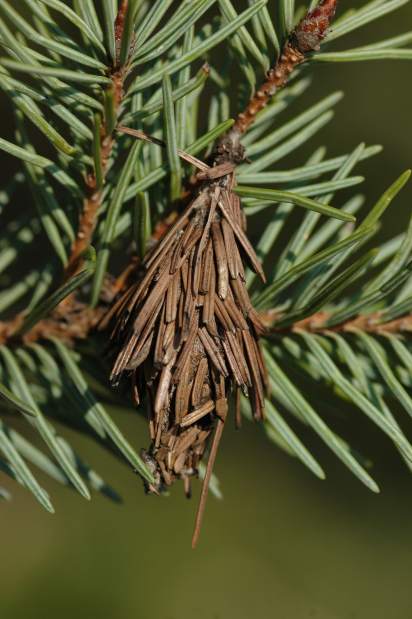Garden Q&A: Bagworms detrimental to a variety of plants
Question: I came home from vacation to find my “Sky Rocket” juniper covered in little brown cone-shaped things that appear to be covered in bits of dead juniper foliage. The plant is not looking very good at all. What are they, and what can I do about them? Is it too late to save my plant?
Answer: Your juniper is battling an infestation of bagworms, a very common pest of landscape plants in mid to late summer. They attack not only junipers but also arborvitae, cedar, pine, cypress and spruce. Occasionally, you will even find them on deciduous trees like apple, elm, oak and birch.
Bagworms aren't actually worms; they are caterpillars. Each one lives inside a slender, silk “bag” that measures about 1 1⁄2 to 2 inches long and is covered in bits of plant material and debris. Adult male bagworms are hairy, clear-winged, black moths. The females spend their entire lives as a caterpillar and never leave the bag.
Bagworms usually are found hanging from the branches of affected trees, and extensive damage can cause defoliation and even death over one or two seasons. Each season in mid-July and early August, inspect any susceptible landscape plants carefully for evidence of those distinctive bags. If you do spot any, carefully remove them. Handpicking the bags is the only sure-fire way of controlling them. Yes, it does take some time to remove them, and yes, they are kind of disgusting, but this is the best way to handle the infestation. Each bag could contain up to 1,000 eggs by the end of the season, so removal is extremely important.
The bags are attached to the plant by a band of silk wrapped around the branch. If the band is left intact, it can lead to girdling and branch death several years after the bag was removed, so instead of pulling off the bags, cut the band off with a sharp pair of shears.
Bagworms are also controlled by several species of spiders (jumping in particular) and parasitic wasps. To use these natural enemies to help control bagworm populations, under-plant susceptible trees and shrubs with any daisy-like flower to attract the tiny, non-stinging parasitic wasps.
Organic product controls include Bt (Bacillus thuringiensis) applied at the end of June when the caterpillars are still young and vulnerable. Bt will not be effective now that the bagworms are mature. Spinosad-based products are another option, but neither of these product options is as effective as hand-removal.
Horticulturist Jessica Walliser co-hosts “The Organic Gardeners” at 7 a.m. Sundays on KDKA Radio. She is the author of several gardening books, including “Attracting Beneficial Bugs to Your Garden: A Natural Approach to Pest Control” and “Good Bug, Bad Bug.” Her website is www.jessicawalliser.com.
Send your gardening or landscaping questions to tribliving@tribweb.com or The Good Earth, 503 Martindale St., 3rd Floor, D.L. Clark Building, Pittsburgh, PA 15212.

